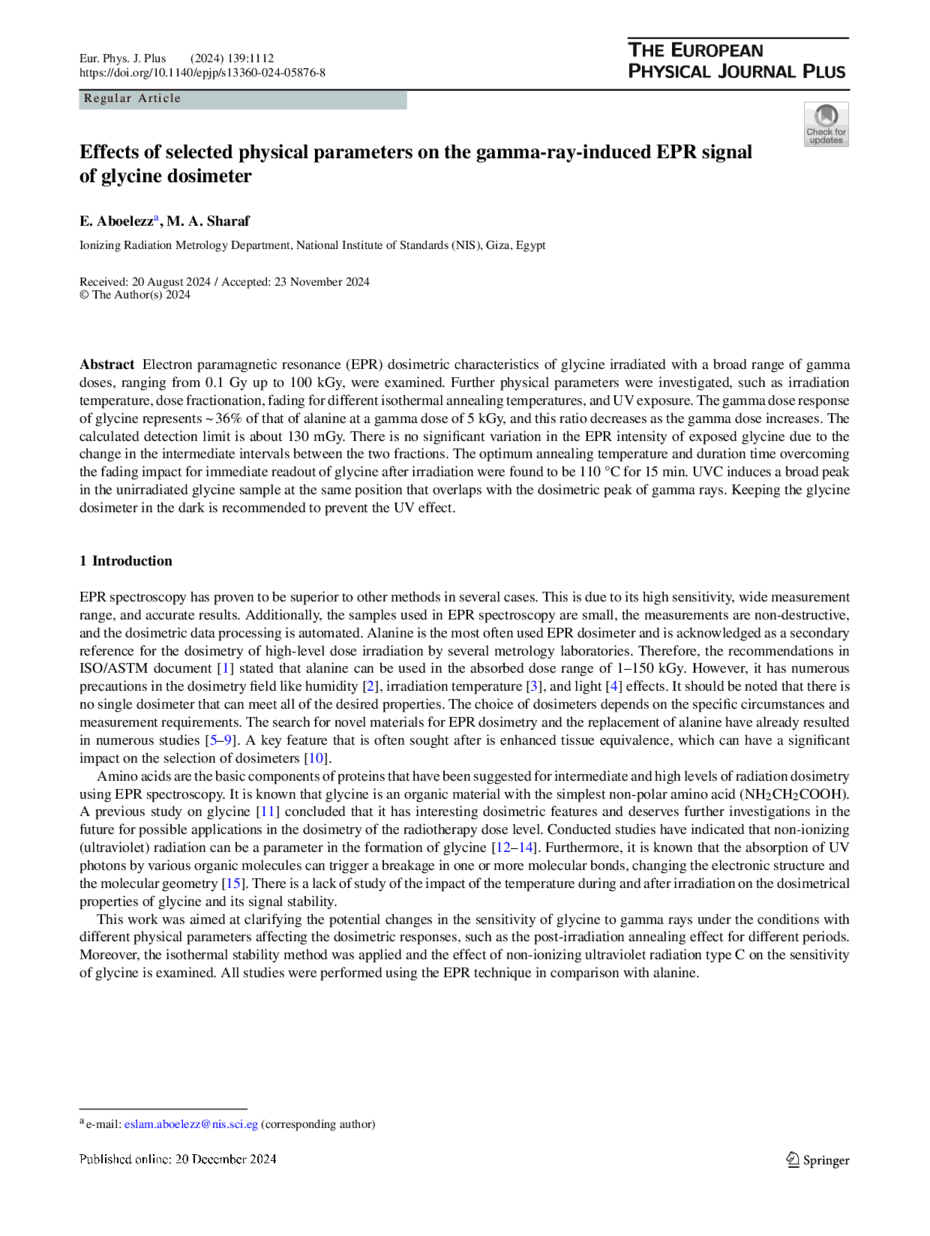https://doi.org/10.1140/epjp/s13360-024-05876-8
Regular Article
Effects of selected physical parameters on the gamma-ray-induced EPR signal of glycine dosimeter
Ionizing Radiation Metrology Department, National Institute of Standards (NIS), Giza, Egypt
Received:
20
August
2024
Accepted:
23
November
2024
Published online:
20
December
2024
Electron paramagnetic resonance (EPR) dosimetric characteristics of glycine irradiated with a broad range of gamma doses, ranging from 0.1 Gy up to 100 kGy, were examined. Further physical parameters were investigated, such as irradiation temperature, dose fractionation, fading for different isothermal annealing temperatures, and UV exposure. The gamma dose response of glycine represents ~ 36% of that of alanine at a gamma dose of 5 kGy, and this ratio decreases as the gamma dose increases. The calculated detection limit is about 130 mGy. There is no significant variation in the EPR intensity of exposed glycine due to the change in the intermediate intervals between the two fractions. The optimum annealing temperature and duration time overcoming the fading impact for immediate readout of glycine after irradiation were found to be 110 °C for 15 min. UVC induces a broad peak in the unirradiated glycine sample at the same position that overlaps with the dosimetric peak of gamma rays. Keeping the glycine dosimeter in the dark is recommended to prevent the UV effect.
The original online version of this article was revised: In this article, the reference Nr. 10 “Aboelezz E, Pogue BW. Review of nanomaterial advances for ionizing radiation dosimetry. Appl Phys Rev. 2023 Jun;10(2):021312. https://doi.org/10.1063/5.0134982. PMID: 37304732; PMCID: PMC10249220” was not counted in the Scopus citation record.
A correction to this article is available online at https://doi.org/10.1140/epjp/s13360-025-06133-2.
© The Author(s) 2024
corrected publication 2025
 Open Access This article is licensed under a Creative Commons Attribution 4.0 International License, which permits use, sharing, adaptation, distribution and reproduction in any medium or format, as long as you give appropriate credit to the original author(s) and the source, provide a link to the Creative Commons licence, and indicate if changes were made. The images or other third party material in this article are included in the article's Creative Commons licence, unless indicated otherwise in a credit line to the material. If material is not included in the article's Creative Commons licence and your intended use is not permitted by statutory regulation or exceeds the permitted use, you will need to obtain permission directly from the copyright holder. To view a copy of this licence, visit http://creativecommons.org/licenses/by/4.0/.
Open Access This article is licensed under a Creative Commons Attribution 4.0 International License, which permits use, sharing, adaptation, distribution and reproduction in any medium or format, as long as you give appropriate credit to the original author(s) and the source, provide a link to the Creative Commons licence, and indicate if changes were made. The images or other third party material in this article are included in the article's Creative Commons licence, unless indicated otherwise in a credit line to the material. If material is not included in the article's Creative Commons licence and your intended use is not permitted by statutory regulation or exceeds the permitted use, you will need to obtain permission directly from the copyright holder. To view a copy of this licence, visit http://creativecommons.org/licenses/by/4.0/.





